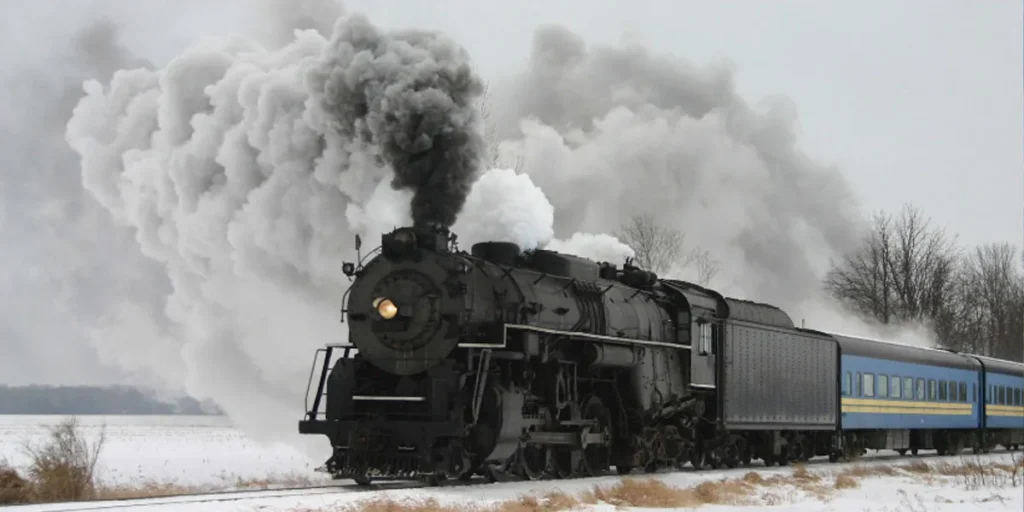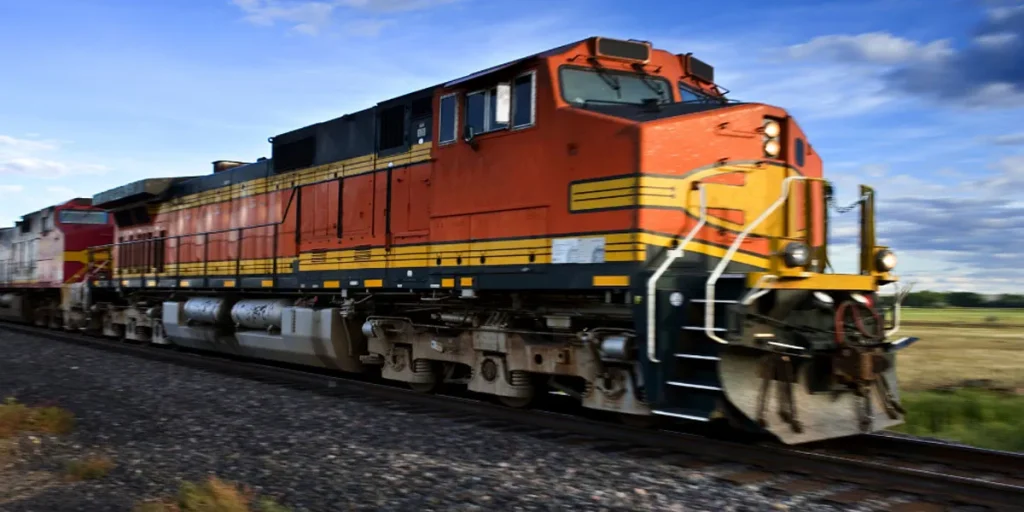The weight of a train can vary greatly, ranging from about 80 to 225 tons for individual locomotives and cars. A train’s total weight depends on its type, size, and cargo.
Trains are critical in transporting both goods and passengers efficiently across long distances.
They come in various forms, including freight trains, which can weigh over 3,000 tons when fully loaded, and passenger trains, which are typically lighter.
Understanding a train’s weight is vital for infrastructure planning and safety, ensuring tracks and bridges can handle the immense loads they carry.
As an integral part of the global supply chain, trains must balance the need for heavy-duty capacity with the engineering constraints of the rail network.

The Heft Of Steel Horses
Imagine a giant made of steel, rushing on tracks with immense power. Trains, or ‘Steel Horses’, amaze us with their size and strength.
They carry people and goods over long distances. But just how heavy are these steel giants? Let’s dig into the numbers and uncover the weight of locomotives and railcars.
Gauging A Locomotive’s Weight
Think of a locomotive as the leader of a train. It pulls all other parts. Locomotives vary in weight depending on their type and purpose. Here’s a weighty breakdown:
- Diesel locomotives: range from 100 to 200 tons
- Electric locomotives: typically weigh around 80 to 180 tons
- Steam locomotives: can be as heavy as 300 tons
The design and materials also affect the weight. Locomotives must be heavy to pull many railcars. Yet, they should not be too heavy to damage the tracks.
Railcars And Their Tonnage
Railcars carry different goods. Each type has a unique load capacity. Here’s a glance at their average tonnage:
| Railcar Type | Empty Weight (Tons) | Max Load (Tons) |
|---|---|---|
| Boxcars | 25-40 | 70-100 |
| Flatcars | 20-25 | 50-120 |
| Tank cars | 30-40 | 100-120 |
| Hopper cars | 20-25 | 100-110 |
The weight of a fully loaded train varies. It depends on the number of railcars and their cargo. Some trains carry thousands of tons across countries!
Types And Their Tipping Scales

Trains come in many sizes and shapes. Some trains carry people. Others move goods. Each type has a different weight. Let’s dive into the scales and see how heavy a train can be.
Freight Train Versus Passenger Train
Freight trains and passenger trains vary in weight. Freight trains carry goods. They can be very long and heavy.
Passenger trains carry people. They are often lighter than freight trains.
- Freight trains can weigh over 6,000 tons
- Passenger trains usually weigh around 400 to 800 tons
Comparing World’s Heaviest Trains
Let’s look at some of the heaviest trains in the world:
| Train Name | Type | Weight (tons) |
|---|---|---|
| BHP Billiton iron ore train | Freight | 99,734 |
| China’s Daqin Railway coal train | Freight | 20,000 |
| India’s Rajdhani Express | Passenger | Around 1,000 |
The BHP Billiton train is one of the heaviest. It carries iron ore in Australia. The Daqin Railway transports coal in China. The Rajdhani Express is a famous passenger train in India.
Factors Affecting A Train’s Weight
Understanding how heavy a train is involves more than just numbers. Various elements contribute to a train’s overall weight.
From the materials used in construction to the number of passengers or cargo onboard, each aspect plays a significant role.
Material And Design Considerations
Trains are built from a mix of sturdy materials, each selected for durability and performance. The choice of materials directly influences weight. Common materials include:
- Steel for framework and wheels
- Aluminium for body panels to reduce weight
- Composites in modern trains for efficiency
Design elements also add to the scale. Bulkier trains with more features generally weigh more than simpler models. Safety features and amenities contribute to the overall weight.
Impact Of Cargo Or Passenger Load
A train’s weight fluctuates with its load. Cargo trains can carry diverse goods, affecting weight significantly.
Passenger trains vary less but still change with the number of occupants. Consider:
| Type of Train | Empty Weight | Full Weight |
|---|---|---|
| Freight Train | 5,000 tons | Up to 20,000 tons |
| Passenger Train | 400 tons | 800 tons |
Cargo types such as metals or grains weigh more than others. Passenger trains add approximately 75 kg per person.
During peak hours, this can significantly increase total weight.
Engineering Behind Massive Machines

Trains are marvels of engineering, combining raw power and refined technology. Their massive weight is vital for stability and traction.
Yet, how do these steel giants glide seamlessly across their metal paths? It’s a symphony of strength, durability, and precision engineering.
Strength Meets Durability
The weight of a train is no small number. Freight trains can tip the scales at up to 21,000 metric tons.
To endure this, trains are built with robust materials. High-strength steel is the star here.
This material resists wear, handles heavy loads, and lasts for years. The engines are powerful, designed to pull huge loads over long distances.
The intricate design ensures each car distributes weight evenly. This protects the machinery and track.
How Tracks Withstand The Weight?
Tracks are just as important as the trains. The tracks must support these behemoths day in and day out.
Railroad tracks use heavy-duty construction. Components include:
- Rails: High-quality steel bears the train’s weight.
- Ties: These hold the rails at the correct distance.
- Ballast: Crushed stone beneath spreads the load, maintains alignment, and drains water.
Regular maintenance keeps tracks in top shape. Specialized crew check and repair any issues. This ensures safe, smooth rides for the massive trains.
| Component | Function | Material |
|---|---|---|
| Rails | Bear train weight | Steel |
| Ties | Space and stabilize rails | Wood or Concrete |
| Ballast | Distribute load and drain water | Crushed Stone |
Rail Networks And Weight Regulations
Understanding how heavy a train is involves delving into rail networks and weight regulations.
Each rail system follows strict rules to ensure trains do not exceed safe weight limits.
These limits protect the tracks, the trains, and most importantly, the lives of those on board. Let’s explore the details that govern the mass and safety of these steel giants.
Safety Standards And Weight Limits
Trains must adhere to specific safety standards for the protection of passengers, cargo, and infrastructure. Here are key factors:
- Axle load regulations – The weight carrying capacity of each wheel.
- Track grade – The steeper the track, the lower the weight limit.
- Bridge load limitations – Bridges have distinct maximum load capacities.
Authorities set weight limits based on these factors to ensure safe travel across miles of track. They divide trains’ total weight by the number of axles to calculate the axle load.
| Type of Train | Average Weight per Axle |
|---|---|
| Freight Train | 30-35 tons |
| Passenger Train | 17-22 tons |
Global Variations In Train Weights
Different countries have unique regulations for train weights. These variations arise due to:
- Diverse engineering standards.
- Varying track conditions.
- Distinct environmental considerations.
For instance, in the United States, trains can be heavier due to robust infrastructure, whereas European trains might be lighter to accommodate for historic tracks.
The table below shows how train weights can differ globally:
| Region | Maximum Freight Train Weight | Maximum Passenger Train Weight |
|---|---|---|
| USA | 20,000-22,000 tons | 800-1,000 tons |
| Europe | 6,000-8,000 tons | 400-700 tons |
FAQs About the Weight of a Train
What Is The Average Weight Of A Train?
The average weight of a train depends on its type. A freight train locomotive weighs about 210-220 tons, while a passenger train car can weigh up to 70 tons. Total train weight varies with the number of cars attached.
How Much Does A Typical Freight Train Weigh?
A typical freight train in the U. S. can weigh up to 6,000 tons. This includes both the weight of the locomotives and the loaded freight cars. The exact weight can vary based on cargo and car count.
Can The Weight Of A Train Affect Speed?
Yes, the weight of a train can significantly affect its speed. Heavier trains require more power to accelerate and take longer to reach full speed. They also require more time to slow down safely.
What Factors Influence A Train’s Weight?
Factors influencing train weight include the type of locomotive, number of cars, construction materials, and the weight of cargo or passengers. Each element adds to the total train weight.
Conclusion
In summing up, the weight of a train varies greatly by type and purpose. From freight behemoths to sleek passenger models, tons can span from a few hundred to many thousands.
Understanding this helps appreciate the engineering marvels facilitating our journeys and commerce daily.
Safe travels on the rails of innovation!
Resources:
https://www.gsa.gov/travel/plan-and-book/transportation-airfare-rates-pov-rates-etc/rail-travel
https://sftool.gov/train
